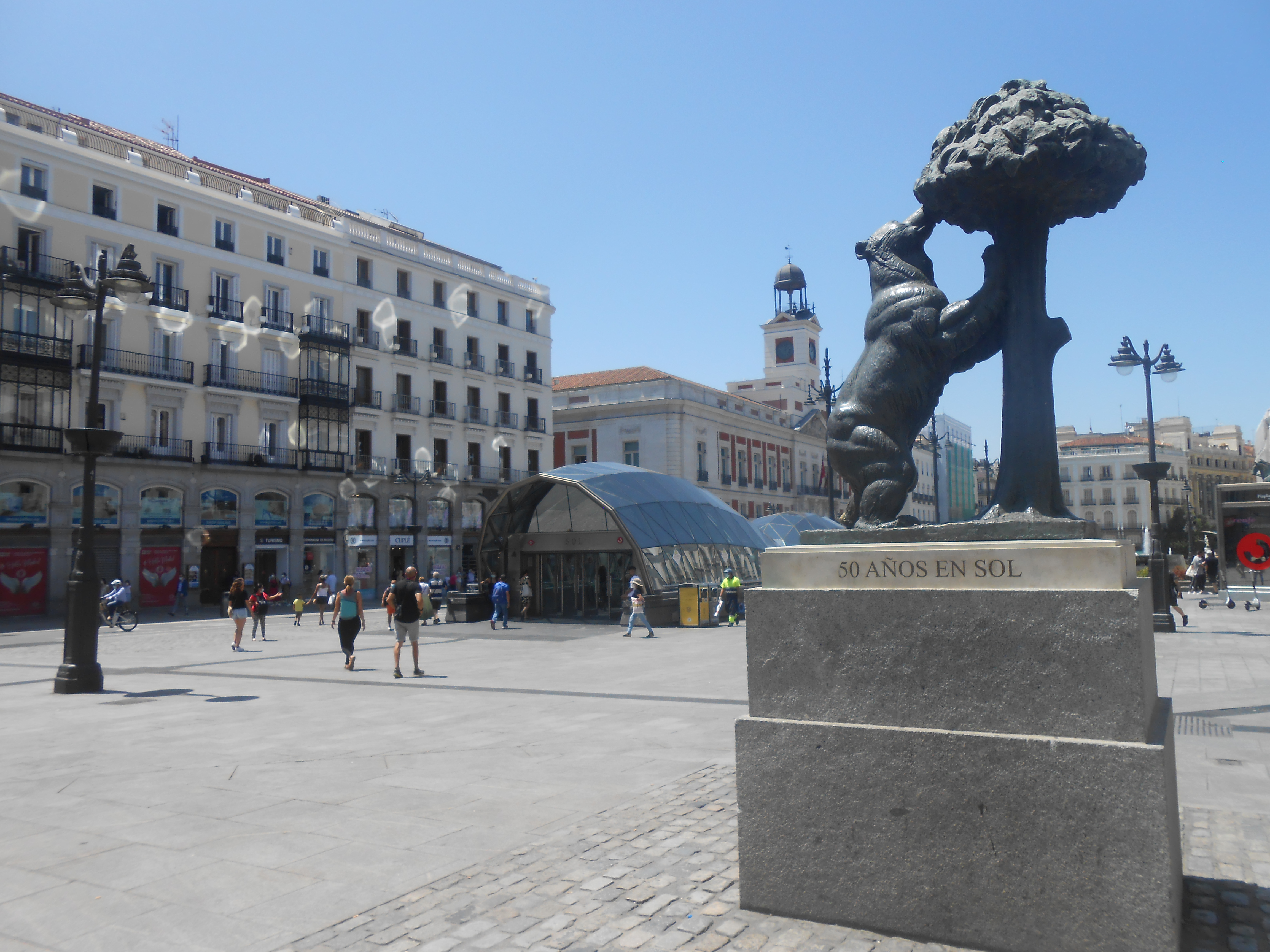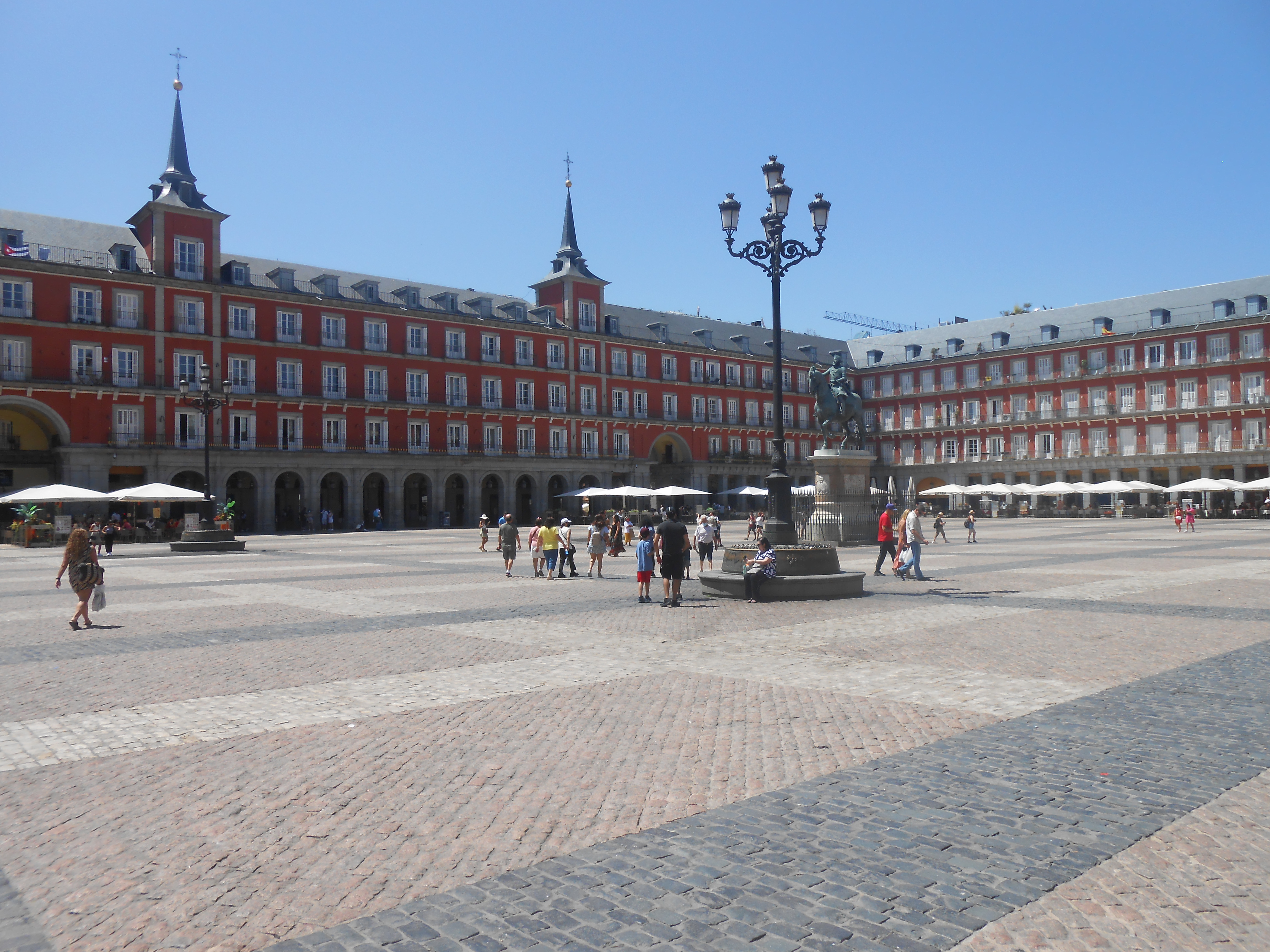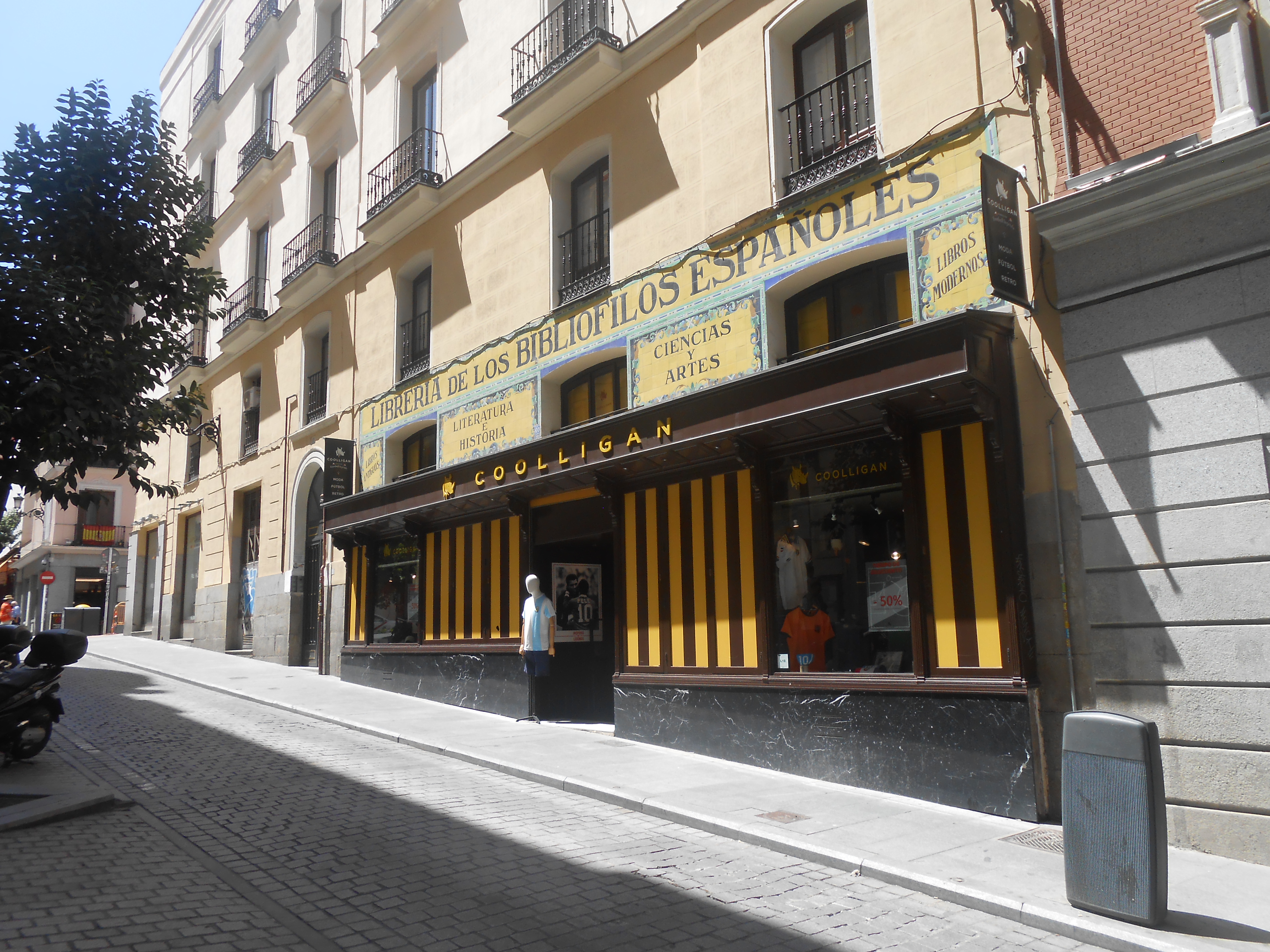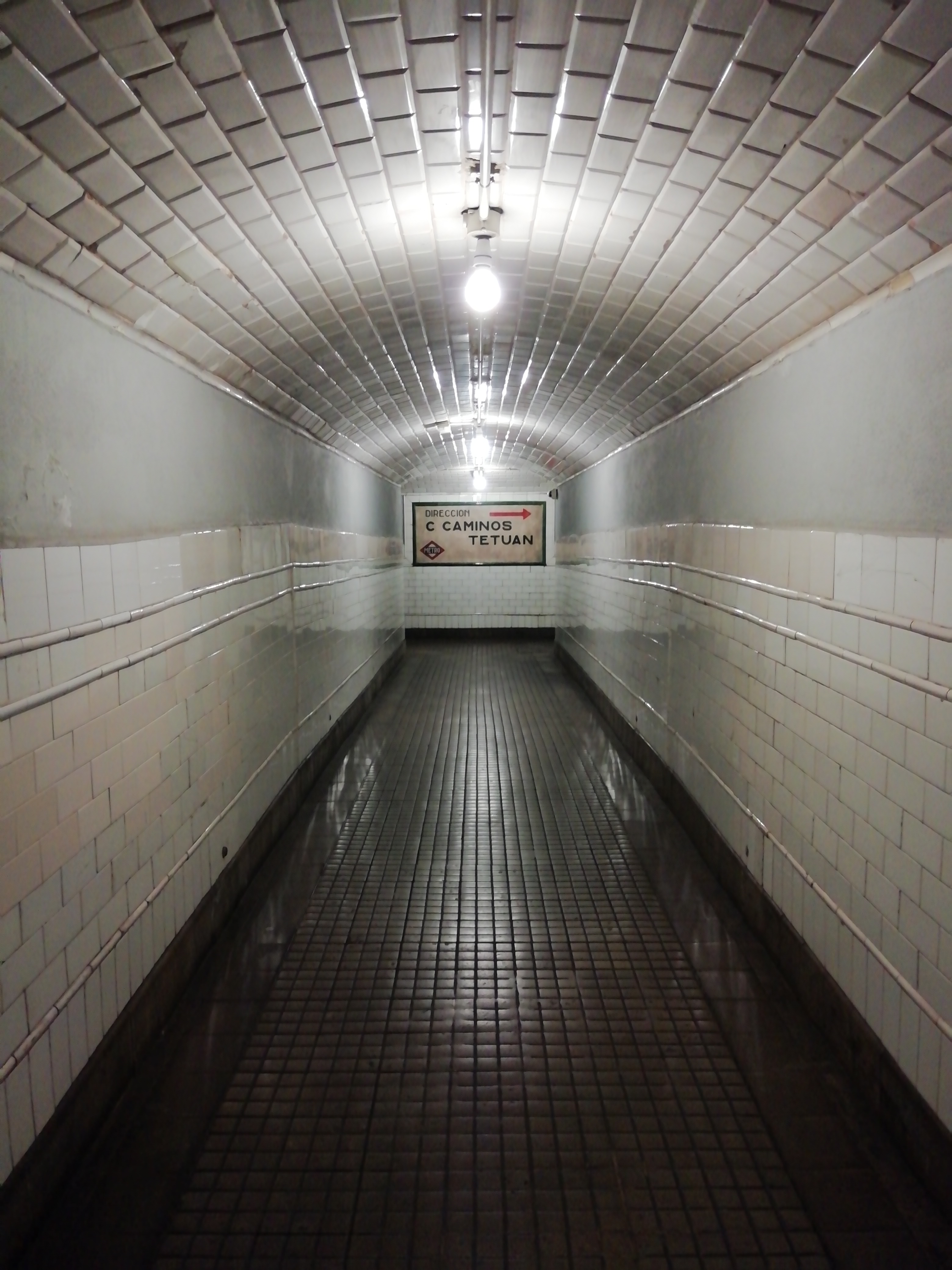Ten tips and things to do in Madrid
(and a few good bars and restaurants to frequent while you are there)

Puerta del Sol and El Oso y el Madroño
I lived in Madrid back in the day and it is a grand place to stay for a visit as well as live. Here, we have a look at a few places to visit and socialise in. We also look at how to get around the extremely well-connected city and its surroundings, and how transport might affect and expand your options.
A BIG word of advice here! Madrid is like any other major city in that it has a centre which can end up as a pricy tourist trap. The area of Puerta del Sol is nice and definitely worth a visit, but if you walk a few blocks in any direction, you will find some other very charming areas with very decent prices. If you want to go a bit beyond walking distance, you will find even more areas a few stops away on the city's underground Metro train system.
Getting a taste for the place.
Madrid is a massive place with A LOT to do! Therefore, this article is really just a small taste of what you can do if you are there for a relatively short stay. We wrote this article with short walking distances in mind. However, bear in mind the excellent transport links that can quickly get you to off-centre but equally-charming neighbourhoods. The word for such a neighbourhood in Spanish is barrio and they are designed more like self-contained villages. This gives each of them their own unique feel. The train links are furthermore capable of sweeping you beyond the city limits. The trains will take you into the mountains, where you can find ancient walled towns with their own unique characters.
We will follow up with a few more articles, with other activities and interesting locations in and around the city. We will even have a look at living in the place!
1. Puerta del Sol and its surroundings
Sol is definitely a scenic port of call as you can see the little bear on the strawberry tree statue. This is an iconic symbol of the city, and adorns the crest of Atlético Madrid F.C. You can also see the old post office building, which is now a local government centre. This building has a famous clock tower that forms a central part to the new year festivities in the city. The clock tower ushers in the new year with its 12 chimes as locals follow the Spanish tradition of eating one grape per chime. Be careful if you're ever doing this and time yourself well as you eat your grapes!

Plaza Mayor in Madrid
If you walk a short distance, you will find Plaza Mayor, from where you can enter the la Latina neighbourhood. This is a stylish and bustling social area full of surprises and party-time options. It also seems to be the only part of the generally-flat city with hills.
2. Calle Fuencarral, the Chueca and Malasaña areas.
Fuencarral is a pedestrianised street that terminates at Gran Vía, the main street, and climbs up gradually about a kilometre to Plaza Quevedo. It also runs parallel to Hortaleza, another stylish street that snakes through the Chueca district.
As you head up the shopping street of Fuencarral, you will pass through several crossroads and plazas. These are entertaining in their own right, and normally feature a Metro stop. These include the junction with Calle Barceló, where there is a museum, the Museo de la Historia de Madrid. This is an old Baroque-style building which had previously housed an orphanage.
Malasaña and the Movida.
On up the street is Glorieta de Bilbao and the Malasaña area. A glorieta is a kind of plaza which might double up as a road junction or roundabout, which is the case here. I normally associate a glorieta with having a fountain or something green and fancy in the middle. This is probably because I used to live around the corner from this particular watery junction. The Glorieta is surrounded by plenty of bars and places to relax and eat. These include the famous chess and literary hub of Café Comercial, dating from the 19th Century. You can see a little more here on the Café Comercial Facebook page.
If you explore a little further along the surrounding streets, you will find many leafy and historical walks. Cardenal Cisneros Street is especially worth a look, being the location of several decently-stocked specialist beerhouses.
The not-so-ancient tradition of botellón.
You may also notice a lot of young ones around the area on weekend nights doing botellón, namely street drinking. The authorities seem to tolerate this and it doesn't appear to cause chaos the way it might do elsewhere. Malasaña was a hub of la Movida Madrileña, a countercultural scene of the late 1970s and early 1980s. This artistic, musical and hedonistic outpouring was a major countercultural aspect of Spain's democratic transition. The area maintains this rebellious youthful feeling alongside the more historical cafés and fountains.
3. Quevedo, Bravo Murillo and Chamberí
At the top of Fuencarral is Plaza Quevedo, maybe lesser known than other areas but charming in its own right. It backs onto Chamberí, an old historical district just off centre, with various small plazas, cinemas and leafy avenues. It is a nice place to live if you ever consider staying in the city for a longer period of time. Bravo Murillo, which continues beyond the plaza as Fuencarral terminates, houses an original version cinema, historic bars and even a fitness park with golf-driving range. This is Parque Santander, and is a great place to stretch your legs or fire a bucketload of golf balls towards oblivion. There is also an outdoor swimming pool across the street in one of the municipal leisure centres. You can pay a few Euros to get in here, so Madrid's distance from the sea feels much less important.
The Metro Museum.
There is also a ghost Metro station on the corner of the streets Luchana and Santa Engracia. It hasn't operated since the 1960s but now functions as a free museum (yes, free). It is on the original Metro line 1 and trains still roar through. A strong glass screen protects visitors, so the authentic feeling of a functioning yet historic station remains.
4. Retiro Park and Paseo del Prado
Madrid has many green spaces and considering its position in the arid central area of the Iberian Peninsula, this is no mean feat. The most famous is Retiro Park, just off centre and now a UNESCO World Heritage Site along with Paseo del Prado. The Prado Museum is on this extremely-wide main thoroughfare, most of which we know as Paseo de la Castellana. Paseo del Prado also goes between two famous plazas, Cibeles and Neptuno. These are the celebratory areas of two of the city's football teams, Real Madrid at Cibeles and Neptuno for the red-and-whites of Atlético Madrid. The street then leads you down to Atocha, with its beautiful train station, which looks like a botanical garden inside.
Retiro Park sits a few hundred metres east of Paseo del Prado. It has rose gardens, a crystal palace and an artificial lake where you can go out on boats. There is also bizarrely a statue of a falling angel, possibly the only public statue of such a thing. You might consider this a wee bit ironic, given the strong Catholic traditions in the city.
5. The Rastro and Lavapiés
We included culturally-diverse Lavapiés with the renowned Rastro market as that is always our route's end whenever we go. Lavapiés has many international restaurants and shops, and is a short walk from Puerta del Sol if you aren't on the market route.
If you do the market route, you normally start around Embajadores Metro station and work your way up the streets. You will fit in with large crowds, browsing through clothes, music and handicraft stalls among other curiosities. Busking and jobbing musicians play and the local bars do a roaring trade.
6. Using the Metro to expand your options
All of the places mentioned in this article are walkable from the centre. However, you could play a game of random choice if you fancy mixing it up a bit. Simply jump on the metro and choose random stations to get out at as their exits usually correspond to plazas. You will rarely be disappointed, more spoiled for choice.
Madrid's population is over 6.5 million, sprawling across its metropolitan area, and stretching towards the mountains. The Metro caters to this large urban and semi-rural population, so local travel has its options for tourists too. It also connects to the regional Cercanías rail network and the national train system. So getting out to somewhere scenic beyond the city limits is very easy.
7. Tinto de verano, beers, aperitivos and the menú del día.
What about eating and drinking? If you find it hot in summer, you might ask for tinto de verano. This might translate into English as summer red and is simple yet effective when tackling the heat. It is a simple mix of cheap red wine and lemonade with a squeeze of lemon and served in ice. This should keep you refreshed whenever the temperatures invariably go upward.
Measures of strong liquor.
Beer comes in the measure of a caña (pronounced /CAN-ya/). It is anywhere in size between a half pint and a 330ml bottle, and comes in a dainty wee glass. Irish beware, you might laugh at the sizes, though not at the prices. You could ask for a doble (/DOB-lay/), which is in a larger glass and should get you up to about 440ml. There don't seem to be any fixed prices but you'd expect to pay between €1.50 and €3 for these. You might get lucky too, with a few spots even offering a €urocaña if you can find them. As we've said, prices aren't all that bad.
Nibbles of food.
You might also expect Madrid bars to set you down a wee nibble as you order. These tend to get more generous if you stay and order more. These are called aperitivos and could be pork scratchings, chips, sausages or chorizos. This is definitely a welcome part of local bar hospitality, and helps line the stomach on a night out. The offering of an aperitivo is quite a Madrileño tradition, and does exist elsewhere, but not everywhere in Spain.
The menú del día, the economic eating option.
If you're feeling a bit more like a full meal but don't want to break the bank, ask for the menú del día. This is the reasonably-priced daily offer and would set you back by between €10 and €15 on average. You normally get a bottle of wine thrown in with the deal and plenty of bread to wipe the plate clean. This is a great idea for the more economic traveller.
A few ideas for eating around town.
- Casa Mingo, which you can see here on their Facebook page, is a historic ciderhouse on Paseo de la Florida, which is reachable on foot from the centre with a little walk through the royal palace gardens and Parque del Oeste. It has been there since the 1880s and offers food both typical of Madrid and the northern region of Asturias. Asturias is a major part of Spanish cider country, with various types of alcoholic apple juice. If you are looking for a simple menu of chicken, spicy sausage, cider and beer, this is the place.
- Museos del Jamón seem to be a fairly typical Spanish establishment and are dotted around the city. They are a strange and interesting place to get a quick bite to eat with a beer, wine or a soft drink while you watch the football on the big screen. They will sell you a nice big ham and cheese baguette for about €2 or less and are distinct given the dozens of legs of ham hanging on the walls, with some museos even containing deli ham counters in them.
- Click here on Restaurantes De María, a chain of Argentinian restaurants around the city. Argentina is known for its quality of beef and this restaurant has both more pricy options and a decent menú del día. The staff might invite you at the end of your meal to a sorbet with Cava, Catalonia's answer to champagne.
- Restaurante La Mordida is a chain of Mexican restaurants co-founded by the famous singer-songwriter Joaquín Sabina. As well as being a renowned Spanish musician, he is also a prominent proponent of Mexico and its traditions. It is very colourful with paintings, murals and cultural displays ranging from Mexican cinema back to the nation's Mesoamerican roots. You can check the menu out by clicking here. You can also have a look inside the restaurant (in Spanish, but you can still have a look) by clicking here.
Madrid has its own very Spanish establishments and a lot of culture from around the Spanish-speaking world, including food and music, and has something original to see and do in almost every corner.
8. Getting out of the city and into the sticks
There isn't enough space in this article to do the surrounding area of Madrid justice, so keep an eye on Travelling Tailtiu. We have upcoming articles on places like Segovia, Toledo, Aranjuez and the mountain range known as the Sierra de Madrid.
Nevertheless, we have this to say here and now. If you are planning a stay in Madrid city, have a look at the Cercanías timetables at this link as well as the high-speed, AVE train here. You will find a selection of options for neighbouring historic towns like Segovia with its Roman aqueduct and the ancient capital of Toledo. This is about 35 minutes by high-speed train and about €11 return.
The Sierra de Guadarrama, the mountains you can see in the distance from the city outskirts, are also an interesting visit. They are the location of various mountain walks and there are a few ski stations there, accessible by Cercanías train. In the summer, they are dry of snow and scorched by sun. They look good either way and you can admire them if you are taking a train or car northward.
9. Words of advice on visiting.
Mad dogs and sun burn.
Madrid is great to visit at any time of the year. However, if you don't tan so much as burn, be careful in summer. Nevertheless, visiting on either side of mid-July to mid-August can be a very pleasant experience. In September, you can sit on outdoor terraces outside any of the thousands of quaint wee bars at 11.00 at night in a t-shirt drinking the aforementioned tinto de verano.
The 40th of May?
"Hasta el 40 de mayo, no te quites el sayo" is a local saying which translates into Hiberno-English (kind of) as 'keep yer jacket on until the 40th of May'.
The saying basically advises us to stay prepared for the possibility of rain until about June 10. After this, showers are extremely rare until about early October. In fairness, rain isn't all that common in the run up to May 40th but a light rain jacket and jumper would be enough. However, you should bring some sun block in summer as the heat goes ever upward in June to peak in mid-July and early August. Consequently, many outdoor swimming pools close in the middle of the day between 2-5PM, given the sun's intensity.
Fortunately, this time happily coincides with lunch hour. Half-sensible locals and tourists escape into restaurants to eat their lunch and hide from the sun. They also get to neck a half bottle or so of wine as it's normally thrown in with the menú.
Keeping an eye on things.
Madrid is like any other city in Europe, and you do need to keep an eye on your belongings whenever you are in the city centre, especially around Puerta del Sol and a few surrounding streets. You might also pay a wee bit more attention whenever you are walking through the large crowds at the Rastro market. By and large, the city is very safe with busy streets and people will be around at most hours of the day.
Irish Pubs...(seriously?!)
Actually yes with a big if, that 'if' being that you will pay a proportionately higher price for your bevvies. However, help would be at hand if you urgently need someone who speaks English. There is a fairly lively community of English speakers in the city and given the interest in rugby or Premier League football from this quarter, Irish pubs do tend to do a fair bit of business. They are also often the hosts of language-exchange events so many locals can be found there practising their English. Or they might simply be having a drink from the larger, pint glasses more common in English-speaking countries. So, if you are dying for a pint of Guinness, you can get the black stuff but bear in mind the higher prices in these places.
The majority of English speakers in the city tend to work in language teaching or translation and the Irish pub might be the venue for get-togethers. The James Joyce Pub, close to Cibeles Plaza has lasted the test of time and does a good trade. The Irish Rover, close to Bernabeu Stadium has also been a mainstay of the city.

Coolligans, a retro football-shirt shop with a historic old shop front close to Puerta del Sol. Click the image to see their Facebook Page
10. Living there; what's that like when it's at home then?
Very pleasant as it happens, and that's coming from an ex-resident! Madrid's a great place to live, with lots to do and eat and see.
Work.
You will however, possibly find yourself teaching English so a language-teaching certificate might become necessary. Unless you work for an international company, language teaching and barwork tend to be the job choices for English-speakers. With barwork, you might find work in the aforementioned Irish pub network. If not, you will probably need a fairly functional Spanish-speaking level to get work in a Spanish establishment.
Flatsharing.
You might also find yourself flatsharing, to split rental costs as three-bedroom flats would cost between €800-1000 monthly.
All that said, and if you don't mind flatsharing, you'll have a great time. There is always something in Madrid to do, the sun shines and the food is excellent. If you fancy learning a useful and widespread language in Spanish, this is the place to stay for a while!
Final Thoughts.
Many northern Europeans think of a Spanish vacation as a sun hol on the Med. However, the central plain and mountains house some great options for city trips and you will find great entertainment, activities and nightlife. There are also outdoor swimming pools around the place if you fancy a dip. However, the locals are much like northern Europeans, preferring Valencia or Cadiz whenever they want to go for a dip.
Getting off-centre.
The main advice of this article is to walk a few hundred metres off-centre in any direction. You will find a plethora of sights, bars, plazas and terraces. All of the places mentioned in this article are walkable from the city centre, except of course, the surrounding countryside. This is accessible on the Cercanías train system, with various linkups with the Metro, like Sol, Atocha and Nuevos Ministerios stations.


Comments are closed.